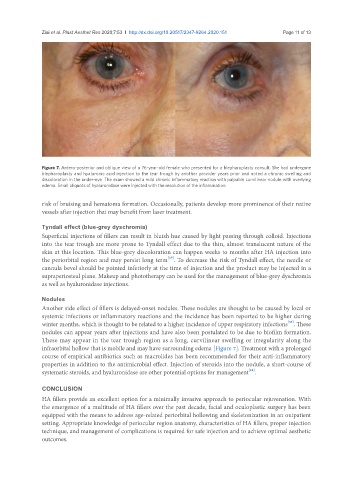Page 619 - Read Online
P. 619
Ziai et al. Plast Aesthet Res 2020;7:53 I http://dx.doi.org/10.20517/2347-9264.2020.151 Page 11 of 13
Figure 7. Antero-posterior and oblique view of a 76-year-old female who presented for a blepharoplasty consult. She had undergone
blepharoplasty and hyaluronic acid injection to the tear trough by another provider years prior and noted a chronic swelling and
discoloration in the under-eye. The exam showed a mild chronic inflammatory reaction with palpable curvilinear nodule with overlying
edema. Small aliquots of hyaluronidase were injected with the resolution of the inflammation
risk of bruising and hematoma formation. Occasionally, patients develop more prominence of their native
vessels after injection that may benefit from laser treatment.
Tyndall effect (blue-grey dyschromia)
Superficial injections of fillers can result in bluish hue caused by light passing through colloid. Injections
into the tear trough are more prone to Tyndall effect due to the thin, almost translucent nature of the
skin at this location. This blue-grey discoloration can happen weeks to months after HA injection into
[29]
the periorbital region and may persist long term . To decrease the risk of Tyndall effect, the needle or
cannula bevel should be pointed inferiorly at the time of injection and the product may be injected in a
supraperiosteal plane. Makeup and phototherapy can be used for the management of blue-grey dyschromia
as well as hyaluronidase injections.
Nodules
Another side effect of fillers is delayed-onset nodules. These nodules are thought to be caused by local or
systemic infections or inflammatory reactions and the incidence has been reported to be higher during
[30]
winter months, which is thought to be related to a higher incidence of upper respiratory infections . These
nodules can appear years after injections and have also been postulated to be due to biofilm formation.
These may appear in the tear trough region as a long, curvilinear swelling or irregularity along the
infraorbital hollow that is mobile and may have surrounding edema [Figure 7]. Treatment with a prolonged
course of empirical antibiotics such as macrolides has been recommended for their anti-inflammatory
properties in addition to the antimicrobial effect. Injection of steroids into the nodule, a short-course of
[24]
systematic steroids, and hyaluronidase are other potential options for management .
CONCLUSION
HA fillers provide an excellent option for a minimally invasive approach to periocular rejuvenation. With
the emergence of a multitude of HA fillers over the past decade, facial and oculoplastic surgery has been
equipped with the means to address age-related periorbital hollowing and skeletonization in an outpatient
setting. Appropriate knowledge of periocular region anatomy, characteristics of HA fillers, proper injection
technique, and management of complications is required for safe injection and to achieve optimal aesthetic
outcomes.

